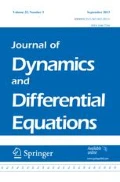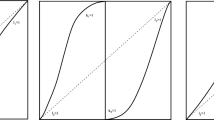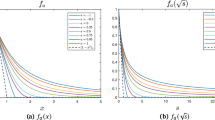Abstract
We investigate dynamics near Turing patterns in reaction–diffusion systems posed on the real line. Linear analysis predicts diffusive decay of small perturbations. We construct a “normal form” coordinate system near such Turing patterns which exhibits an approximate discrete conservation law. The key ingredients to the normal form is a conjugation of the reaction–diffusion system on the real line to a lattice dynamical system. At each lattice site, we decompose perturbations into neutral phase shifts and normal decaying components. As an application of our normal form construction, we prove nonlinear stability of Turing patterns with respect to perturbations that are small in \(L^1\cap L^\infty \), with sharp rates, recovering and slightly improving on results in Johnson and Zumbrun (Ann Inst H Poincaré Anal Non Linéaire 28:471–483, 2011) and Schneider (Commun Math Phys 178:679–702, 1996).
Similar content being viewed by others
References
Bricmont, J., Kupiainen, A.: Renormalization group and the Ginzburg–Landau equation. Commun. Math. Phys. 150, 193–208 (1992)
Bricmont, J., Kupiainen, A.: Stability of moving fronts in the Ginzburg–Landau equation. Commun. Math. Phys. 159, 287–318 (1994)
Deng, K., Levine, H.A.: The role of critical exponents in blow-up theorems: the sequel. J. Math. Anal. Appl. 243, 85–126 (2000)
Gallay, T., Scheel, A.: Diffusive stability of oscillations in reaction–diffusion systems. Trans. Am. Math. Soc. 363, 2571–2598 (2011)
Henry, D.: Geometric Theory of Semilinear Parabolic Equations. Lecture Notes in Mathematics, vol. 840. Springer, Berlin (1981)
Herrero, M.A., Velázquez, J.J.L.: Some results on blow up for semilinear parabolic problems. In: Degenerate Diffusions (Minneapolis, MN, 1991). IMA Volumes in Mathematics and its Applications, vol. 47, pp. 105–125. Springer, New York (1993)
Johnson, M.A.: Nonlinear stability of periodic traveling wave solutions of the generalized Korteweg–de Vries equation. SIAM J. Math. Anal. 41, 1921–1947 (2009)
Johnson, M.A., Zumbrun, K.: Nonlinear stability of periodic traveling wave solutions of systems of viscous conservation laws in the generic case. J. Differ. Equ. 249, 1213–1240 (2010)
Johnson, M.A., Zumbrun, K.: Nonlinear stability of periodic traveling-wave solutions of viscous conservation laws in dimensions one and two. SIAM J. Appl. Dyn. Syst. 10, 189–211 (2011)
Johnson, M.A., Zumbrun, K.: Nonlinear stability of spatially-periodic traveling-wave solutions of systems of reaction–diffusion equations. Ann. Inst. H. Poincaré Anal. Non Linéaire 28, 471–483 (2011)
Johnson, M.A., Zumbrun, K., Noble, P.: Nonlinear stability of viscous roll waves. SIAM J. Math. Anal. 43, 577–611 (2011)
Lunardi, A.: Analytic Semigroups and Optimal Regularity in Parabolic Problems. Progress in Nonlinear Differential Equations and Their Applications, vol. 16. Birkhäuser Verlag, Basel (1995)
Mielke, A.: Über maximale \(L^p\)-Regularität für Differentialgleichungen in Banach- und Hilbert-Räumen. Math. Ann. 277, 121–133 (1987)
Mielke, A.: Instability and stability of rolls in the Swift–Hohenberg equation. Commun. Math. Phys. 189, 829–853 (1997)
Murray, J.D.: Mathematical Biology. I: An Introduction. Interdisciplinary Applied Mathematics, vol. 17, 3rd edn. Springer, New York (2002)
Murray, J.D.: Mathematical Biology. II: Spatial Models and Biomedical Applications. Interdisciplinary Applied Mathematics, vol. 18, 3rd edn. Springer, New York (2003)
Reed, M., Simon, B.: Methods of Modern Mathematical Physics. IV. Analysis of Operators. Academic Press [Harcourt Brace Jovanovich Publishers], New York (1978)
Sandstede, B., Scheel, A.: On the stability of periodic travelling waves with large spatial period. J. Differ. Equ. 172, 134–188 (2001)
Sandstede, B., Scheel, A., Schneider, G., Uecker, H.: Diffusive mixing of periodic wave trains in reaction–diffusion systems. J. Differ. Equ. 252, 3541–3574 (2012)
Scarpellini, B.: \({\cal{L}}^2\)-perturbations of periodic equilibria of reaction diffusion systems. NoDEA Nonlinear Differ. Equ. Appl. 1, 281–311 (1994)
Schneider, G.: Diffusive stability of spatial periodic solutions of the Swift–Hohenberg equation. Commun. Math. Phys. 178, 679–702 (1996)
Schneider, G.: Nonlinear stability of Taylor vortices in infinite cylinders. Arch. Ration. Mech. Anal. 144, 121–200 (1998)
Turing, A.: The chemical basis of morphogenesis. Philos. Trans. R. Soc. Lond. B 237, 37–72 (1952)
Uecker, H.: Diffusive stability of rolls in the two-dimensional real and complex Swift–Hohenberg equation. Commun. Partial Differ. Equ. 24, 2109–2146 (1999)
Zelik, S., Mielke, A.: Multi-pulse evolution and space–time chaos in dissipative systems. Mem. Am. Math. Soc. 198, vi+97 (2009)
Acknowledgments
This work was partially supported by the National Science Foundation through Grant NSF-DMS-0806614.
Author information
Authors and Affiliations
Corresponding author
Additional information
Dedicated to the memory of Klaus Kirchgässner, in deep gratitude for his guidance and inspiration.
Appendix
Appendix
1.1 Estimates on Nonlinear Terms
In this section, we derive the estimates on the nonlinear terms \(\mathbf{N}^\theta \) and \(\mathbf{N}^\mathbf{w}\) in our normal form (2.21).
Lemma 6.1
For \(\Vert \underline{\mathbf{W}}\Vert _{X_{\mathrm{ch}}}, \Vert \underline{\theta }\Vert _{\ell ^1}<\varepsilon \), where \(\varepsilon \) is sufficiently small(\(0<\varepsilon \le \varepsilon _0\)), there exists a nondecreasing function \(C(\varepsilon )>0\) such that, for all \(1\le p\le \infty \), the nonlinear terms in system (2.21) have the following estimates.
Proof
We point out that throughout the proof, we repeatedly exploit the fact that the \(L^2\) scalar product of an even function and an odd function are zero. We also recall that \(\mathbf{u}_\star \) is even and \(\mathbf{u}_{\mathrm{ad}}\) is odd. By equations (2.9),(2.10) and (2.21), we obtain
We recall here that \(\underline{\mathbf{E}}\) is defined in (2.18) and point out that the term in \(VII_j\) involving \(\dot{\mathbf{W}}_j\) in fact cancels with a contribution from \(\dot{\mathbf{H}}_j\). We now prove the estimate of \(\mathbf{N}^\theta _j\).
Estimate on \(I_j\): \(|I_j|\le C(\varepsilon )\left( |(\delta _+\underline{\theta })_j|+ |(\delta _-\underline{\theta })_j|+\Vert \mathbf{W}_j\Vert _{L^p}\right) |(\delta _+\underline{\mathbf{W}})_j(-\pi )|\).
We first recall that \(\mathbf{H}_j\) is defined in (2.10) and (2.13). We claim that the number \(c_j\), appearing in the definition of \(\mathbf{H}_j^2\) as in (2.15) and (2.16), can be estimated as
where we use notation \(\delta ^2=\delta _+\delta _-\). In fact, we have
We also have \(|\mathbf{H}_j(x)|\le C(\varepsilon )(|(\delta _+\underline{\theta })_j| +|(\delta _-\underline{\theta })_j|+|\theta _j|\Vert \mathbf{W}_j\Vert _{L^p})\), from which we obtain the estimate.
Estimate on \(II_j\): \(|II_j|\le C|\theta _j|^2|(\delta _+\underline{\mathbf{W}})_j(-\pi )|\).
This is straightforward.
Estimate on \(III_j\): \(|III_j|\le C|\theta _j||(\delta _+\partial _x\underline{\mathbf{W}})_j(-\pi )|\).
This is straightforward.
Estimate on \(IV_j\): \(|IV_j|\le C\left[ |(\delta _+\underline{\theta })_j|^2+ |(\delta _-\underline{\theta })_{j}|^2+|(\delta _+\underline{\theta })_{j}+(\delta _-\underline{\theta })_{j}| (|\theta _{j+1}|^3\right. \left. \qquad \qquad \qquad \qquad \qquad \qquad \qquad \qquad \qquad +|\theta _{j}|^3+|\theta _{j-1}|^3)\right] \).
We first simplify \(IV_j\) and obtain
Then, it is not hard to see that
which establishes the estimate on \(IV_j\) as claimed.
Estimate on \(V_j\): \(|V_j|\le C(\varepsilon )\bigg ( |(\delta _+\underline{\theta })_j|^2+|(\delta _-\underline{\theta })_j|^2+\Vert \mathbf{W}_j^2\Vert _{L^p}\bigg )\).
Noting that \(|V_j|\le C(\varepsilon )\Vert (\mathbf{W}_j+\mathbf{H}_j)^2\Vert _{L^p}\) and applying the estimate of \(\mathbf{H}_j\) to the inequality lead to the above estimate.
Estimate on \(\fancyscript{S}_j\): \(|\fancyscript{S}_j|\le C(\varepsilon )\).
This is straightforward.
Combining our estimates of \(II_j-V_j\) and \(\fancyscript{S}_j\), we obtain the first inequality in (6.1).
Now, we have to show that the estimate of \(\mathbf{N}^\mathbf{w}_j\) in (6.1) is true.
Estimate on \(VI_j\):
First, for \(f\) \(2\pi \)-periodic and smooth, we have
If in addition, \(f\) is odd, we have
The latter implies that
Moreover, by the former inequality, we have
Estimate on \(VII_j\):
Noting that \((\underline{\mathbf{E}}*\underline{\theta })_j\) is the linear part of \(\mathbf{H}_j+\mathbf{u}_\star (x-\theta _j)-\mathbf{u}_\star (x)\) and there is no term involving \(\dot{\mathbf{W}}_j\) in \(VII_j\), we have
where \(\tilde{\dot{c}}_j=\dot{c}_j+\langle \dot{\mathbf{W}}_j(x),\mathbf{u}_{\mathrm{ad}}(x-\theta _j)-\mathbf{u}_{\mathrm{ad}}(x)\rangle \).
First, we note that
Moreover, we claim that
In fact, we have
which establishes the claim and thus the estimate on \(VII_j\).
Estimate on \(VIII_j\):
The calculation is straightforward using the expressions for \(\mathbf{K}_j\) and \(\dot{\theta }_j\).
Estimate on \(IX_j\):
The calculation is straightforward using the estimate on \(\mathbf{H}_j\).
Estimate on \(\frac{\partial \mathbf{G}_j}{\partial \mathbf{W}_j}X_j\):
Integrating by parts, we have
Therefore, we have
Estimate on \((\mathrm{\,id}\,-\frac{\partial \mathbf{G}_j}{\partial \mathbf{W}_j})^{-1}\): For any \(\underline{\theta }\in \ell ^\infty \) and \(p\in [1, \infty ]\), there exists a constant \(C>0\) such that
Combining estimates on \(VI_j\) to \(IX_j\), \(\frac{\partial \mathbf{G}_j}{\partial \mathbf{W}_j}\) and \((\mathrm{\,id}\,-\frac{\partial \mathbf{G}_j}{\partial \mathbf{W}_j})^{-1}\), we obtain the second inequality in (6.1). \(\square \)
Moreover, we have the following lemma.
Lemma 6.2
There exist \(C>0\) and \(\eta >0\) such that, for all \((\underline{\theta },\underline{\mathbf{W}})\in Y\) with its \(Y\)-norm smaller than \(\eta \), we have
Proof
The estimates are obtained through a direct calculation from the estimates in Lemma 6.1. We sketch the computation for \(\Vert \mathbf{N}^\theta (s)\Vert _{\ell ^1}\), and the others follow similarly.
First, for terms only involving \(\underline{\theta }\), we notice that
Second, for terms involving \(\underline{\mathbf{W}}\), we observe that
Similarly, for \(\sum _{j\in \mathbb {Z}}|\theta _j||(\delta _+\underline{\mathbf{W}})_j(-\pi )|\), we have
Using the “homogeneous matching boundary conditions” (2.11), we have
We plug the latter estimate into the former one and obtain that
For \(\sum _{j\in \mathbb {Z}}\Vert \mathbf{W}_j\Vert _{L^p}|(\delta _+\underline{\mathbf{W}})_j(-\pi )|\), we take \(p=2\) and follow steps as above, obtaining the following estimate.
For \(\sum _{j\in \mathbb {Z}}\Vert \mathbf{W}_j^2\Vert _{L^p}|\), we take \(p=1\) and obtain that
Combining the above estimate, we establish the first inequality in the lemma. \(\square \)
1.2 Bloch Wave Decomposition
In this section, we present the Bloch wave decomposition of the linear operator \(\widetilde{A}\). We first recall that \(\widetilde{A}\), as in (3.1), is defined as
We introduce the direct integral [17, XIII.16]
The direct integral is an isometric isomorphism with inverse
The following result from [14, 20] characterizes the Bloch wave decomposition of \(\widetilde{A}\).
Theorem 2
(Bloch wave decomposition) The linear operator \(\widetilde{A}\) is diagonal in Bloch wave space. To be precise,
where by \(\widehat{A}=\int \limits _{-\frac{1}{2}}^{\frac{1}{2}}B(\sigma )\mathrm{d}\sigma \), we mean that, given any \(\mathbf{u}\in L^2(\mathbb {T}_1, (L^2(\mathbb {T}_{2\pi }))^n)\),
Moreover, we have the following spectral mapping property.
1.3 Spectral Properties of \(\{\widehat{A}_{\mathrm{ch}}(\sigma )\} _{\sigma \in [-\frac{1}{2},\frac{1}{2}]}\)
We recall that \(\widehat{A}_{\mathrm{ch}}(\sigma )\) is defined in (3.9) as \(\widehat{A}_{\mathrm{ch}}(\sigma )=\fancyscript{F}_nB(\sigma )\fancyscript{F}_n^{-1}\) and \(Y_q\) in (3.15) for \(1\le q\le \infty \). We are concerned with their spectral properties as unbounded operators in \(Y_q\), which is useful for the derivation of the estimates for \(M(t,\sigma )\) as defined in (3.23).
We first show the well-definedness of \(\widehat{A}_{\mathrm{ch}}(\sigma )\) in \(Y_q\) in the following lemma.
Lemma 6.3
For any given \(\sigma \in [-\frac{1}{2},\frac{1}{2}]\), \(\widehat{A}_{\mathrm{ch}}(\sigma )\) is an unbounded closed operator in \(Y_2\), that is,
where \(\fancyscript{D}_2(\widehat{A}_{\mathrm{ch}}(\sigma ))=\{\mathbf{w}\in Y_2\mid \{(1+m^2)\mathbf{w}_m\}_{m\in \mathbb {Z}}\in Y_2\}\) and \(\underline{\mathbf{h}}=\{\mathbf{h}_\ell \}_{\ell \in \mathbb {Z}}= \frac{1}{2\pi }\int \limits _{-\pi }^{\pi }\mathbf{f}^\prime (\mathbf{u}_\star (x))\mathrm{e}^{-\mathrm{i}kx} \mathrm{d}x\). Moreover, \(\widehat{A}_{\mathrm{ch}}(\sigma )\) can naturally be considered as an unbounded closed operator in \(Y_q\), with \(\fancyscript{D}_q(\widehat{A}_{\mathrm{ch}}(\sigma ))=\{\mathbf{w}\in Y_q\mid \{(1+m^2)\mathbf{w}_m\}_{m\in \mathbb {Z}}\in Y_q\}\), for all \(1\le q \le \infty \).
Proof
The expression for \(\widehat{A}_{\mathrm{ch}}(\sigma )\) in \(Y_2\) follows from a direct calculation. The extension to \(Y_q\) follows from the fact that the set \(\{\underline{\mathbf{w}}\in Y_\infty \mid \underline{\mathbf{w}} \text { has finitely many nonzero entries}\}\) is dense in \(Y_q\) and \(\fancyscript{D}_q(\widehat{A}_{\mathrm{ch}}(\sigma ))\), for all \(q\in [1,\infty ]\). \(\square \)
We then have the following proposition.
Proposition 6.4
For any fixed \(\sigma \in [-\frac{1}{2},\frac{1}{2}]\) and \(p\in [1,\infty ]\), \(\widehat{A}_{\mathrm{ch}}(\sigma )\) defined in \(Y_q\) is sectorial and has compact resolvent. In fact, there exist \(C>0\), \(\omega \in (\pi /2,\pi )\) and \(\lambda _0\in \mathbb {R}\), independent of \(\sigma \) and \(q\), such that the sector \(S(\lambda _0,\omega )=\{\lambda \in \mathbb {C}\mid 0\le |\arg (\lambda -\lambda _0)| \le \omega , \lambda \ne \lambda _0\}\subseteq \rho (\widehat{A}_{\mathrm{ch}}(\sigma ))\) and
Moreover, for any fixed \(\sigma \in [-\frac{1}{2},\frac{1}{2}]\), the spectrum of \(\widehat{A}_{\mathrm{ch}}(\sigma )\) is independent of the choice of its underlying space \(Y_q\) and thus denoted as \(\mathop {\mathrm{spec}}(\widehat{A}_{\mathrm{ch}}(\sigma ))\), for any \(q\in [1,\infty ]\), with \(\mathop {\mathrm{spec}}(\widehat{A}_{\mathrm{ch}}(\sigma ))=\mathop {\mathrm{spec}}(B(\sigma ))\), consisting only of isolated eigenvalues with finite multiplicity.
Proof
We view \(\widehat{A}_{\mathrm{ch}}(\sigma )\) as a perturbation of the Laplacian in the discrete Fourier space, that is,
where \(L(\sigma )\underline{\mathbf{w}}=\{-(\sigma +\ell )^2D\mathbf{w}_\ell \}_{\ell \in \mathbb {Z}}\) and \(H\underline{\mathbf{w}}=\{\sum _{k\in \mathbb {Z}}\mathbf{h}_{\ell -k}\mathbf{w}_k\}_{\ell \in \mathbb {Z}}\). It is straightforward to verify that the proposition holds for the Laplacian \(L(\sigma )\). We only have to show that the perturbation \(H\) is good enough to preserve these properties. Noting that \(H\in \fancyscript{L}((\ell ^p)^n)\) for any \(p\in [1,\infty ]\) with its norm uniformly bounded, we have, for \(\lambda \in \rho (L(\sigma ))\), \(|\lambda |\) sufficiently large,
All assertions in the proposition easily follows from this expression (6.7), except for the fact that the spectrum of \(\widehat{A}_{\mathrm{ch}}(\sigma )\) is independent of \(q\).
To prove this property, we denote the spectrum of \(\widehat{A}_{\mathrm{ch}}(\sigma )\) defined on \(Y_q\) as \(\mathop {\mathrm{spec}}(\widehat{A}_{\mathrm{ch}}(\sigma ),q)\), which consists of eigenvalues with finite multiplicity, accumulating at infinity, only. Given any eigenfunction \(\underline{\mathbf{v}}=\{\mathbf{v}_j\}_{j\in \mathbb {Z}}\), \(\underline{\mathbf{v}}\) belongs to \(\bigcap _{q\in [1,\infty ]}Y_q\) since \(\underline{\mathbf{v}}\) are smooth, that is, \(\mathbf{v}_j\) decays algebraically with any rate. This establishes \(\mathop {\mathrm{spec}}(\widehat{A}(\sigma ),q)=\mathop {\mathrm{spec}}(\widehat{A}(\sigma ),p)\), for any \(p, q\in [1,\infty ]\). \(\square \)
1.4 Perturbation Results
We apply perturbation theory to the Bloch wave operator \(B(\sigma )\) for \(\sigma \) near \(0\) and obtain more detailed spectral information, including the Taylor expansion of \(d\) in Hypotheses 1.2.
To this end, we define
where \(H^2_{\perp }=\{\mathbf{w}\in (H^2(\mathbb {T}_{2\pi }))^n\mid \langle \mathbf{w}, \mathbf{u}_\star ^\prime \rangle =0\}.\) A standard implicit-function-theorem argument shows that there are a small neighborhood of \(\sigma \) at the origin and a smooth function \((\lambda (\sigma ), \mathbf{w}(\sigma ))\) with \((\lambda (\sigma ), \mathbf{w}(\sigma ))=0\) on this neighborhood such that \(F(\sigma , \lambda (\sigma ),\mathbf{w}(\sigma ))=0\). We denote \(\mathbf{e}(\sigma )=\mathbf{u}_\star ^\prime +\mathbf{w}(\sigma )\). Similarly, replacing \(B(\sigma )\) with its adjoint \(B^*(\sigma )\), we obtain a smooth continuation of \(\mathbf{u}_{\mathrm{ad}}\), denoted as \(\mathbf{e}^*(\sigma )\). Without loss of generality, we can assume that \(\langle \mathbf{e}(\sigma ),\mathbf{e}^*(\sigma )\rangle =1\). Moreover, we have the following proposition.
Proposition 6.5
There exist positive numbers \(\gamma _0\) and \(\gamma _1\) such that for any \(|\sigma |\le \gamma _0\) in \(\mathbb {R}\), \(B(\sigma )\) has only one simple eigenvalue within the strip \(|\mathop {\mathrm{Re}}\lambda |\le \gamma _1\) in \(\mathbb {C}\), which is exactly the continuation \(\lambda (\sigma )\) of the eigenvalue \(\lambda (0)=0\). Moreover, \(\lambda (\sigma )\) has the Taylor expansion,
where \(-\gamma _1/4\le -2d\sigma ^2<Re\lambda (\sigma )<-\frac{d}{2}\sigma ^2\), for all \(\sigma \in [-\gamma _0,\gamma _0]\) and
Proof
We first derive the explicit expression of \(d\). To do that, taking first and second derivative with respect to \(\sigma \) of \(F(\sigma ,\lambda (\sigma ),\mathbf{w}(\sigma ))=0\), taking the inner product of the derivatives with \(\mathbf{u}_{\mathrm{ad}}\) and letting \(\sigma =0\), we have
Noting that \(\mathop {\mathrm{span}}\{\mathbf{u}_{\mathrm{ad}}\}\perp Rg(B(0))\) and the inner product of an even function and an odd function is always 0, we have
It remains to prove the uniqueness of the eigenvalue of \(B(\sigma )\) in a vertical strip centered at the origin for sufficiently small \(\sigma \). First, there is no eigenvalue within the strip far away from the origin due to the fact that, by Proposition 6.4, \(\mathop {\mathrm{spec}}(B(\sigma ))\) is in the same sector for every \(\sigma \in [-\frac{1}{2}, \frac{1}{2}]\). Secondly, the uniqueness within a small neighborhood of the origin follows from the above perturbation results. For the region inbetween, compactness and the local robustness of resolvent guarantee the absence of eigenvalues within this area. \(\square \)
Remark 6.6
-
(i)
We stress that we may choose \(\gamma _0\) as small as desired.
-
(ii)
The uniqueness implies that, for \(|\sigma |\) sufficiently small, \(\lambda (\sigma )\) is a real number since its complex conjugate is also an eigenvalue.
1.5 Properties of Analytic Semigroups \(\{\mathrm{e}^{\widehat{A}_{\mathrm{ch}}(\sigma ) t}\} _{\sigma \in [-\frac{1}{2},\frac{1}{2}]}\)
In this section, we will derive various estimates on \(\mathrm{e}^{\widehat{A}_{\mathrm{ch}}(\sigma ) t}\). We first note that by [5, 1.4] the interpolation space \(\fancyscript{D}_q(\widehat{A}_{\mathrm{ch}}(\sigma )^\alpha )\) is independent of \(\sigma \),
We then recall the definitions of \(Y_{q,\mathrm{c}}(\sigma )\), \(Y_{q,\mathrm{s}}(\sigma )\), \(\widehat{A}_{\mathrm{c}}(\sigma )\) and \(\widehat{A}_{\mathrm{s}}(\sigma )\) from (3.18). We now have the following proposition.
Proposition 6.7
For every \(q\in [1, +\infty ]\) and \(\alpha >0\), there exist positive constants \(\epsilon \in (0,1)\), \(\gamma _2\), \(C(q)\), \(C(\alpha )\) and \(C(\alpha , q)\) such that
Proof
We first derive estimates for the case \(|\sigma |\le \gamma _0\). For \(\widehat{A}_{\mathrm{c}}(\sigma )\), we have \(\mathrm{e}^{\widehat{A}_{\mathrm{c}}(\sigma )t}=\mathrm{e}^{\lambda (\sigma )t}\). The first two inequalities follow directly from the fact that \(\mathop {\mathrm{Re}}\lambda (\sigma )<-\frac{d}{2}\sigma ^2\) and \(\mathbf{e}(\sigma )\) is smooth, by Proposition 6.5, for \(|\sigma |\le \gamma _0\).
For \(\widehat{A}_{\mathrm{s}}(\sigma )\), by Propositions 6.4 and 6.5, for any \(\sigma \in (-\gamma _0,\gamma _0)\) and \(q\in [1,\infty ]\),
Moreover, for every \(q\in [1, +\infty ]\), there exists a positive constant \(C(q)\) such that
Thus, by [5, Thms. 1.3.4, 1.4.3], we immediately obtain the two inequalities for \(\widehat{A}_{\mathrm{s}}(\sigma )\). The first inequality on \(\widehat{A}_{\mathrm{ch}}(\sigma )\) follows directly by combining the first inequality for \(\widehat{A}_{\mathrm{c}}(\sigma )\) and the first inequality for \(\widehat{A}_{\mathrm{s}}(\sigma )\).
We now derive the estimates for the case \(\gamma _0<|\sigma |\le \frac{1}{2}\). By a similar analysis as in Proposition 6.5, there exists a positive constant \(\gamma _2\) such that
It is then not hard to conclude that
Moreover, for every \(q\in [1, +\infty ]\), there exists a positive constant \(C(q)\) such that
Therefore, again by [5, Thms. 1.3.4, 1.4.3], we immediately obtain the last two inequalities for \(\widehat{A}_{\mathrm{ch}}(\sigma )\), which concludes the proof. \(\square \)
Rights and permissions
About this article
Cite this article
Scheel, A., Wu, Q. Diffusive Stability of Turing Patterns via Normal Forms. J Dyn Diff Equat 27, 1027–1076 (2015). https://doi.org/10.1007/s10884-013-9335-0
Received:
Published:
Issue Date:
DOI: https://doi.org/10.1007/s10884-013-9335-0




